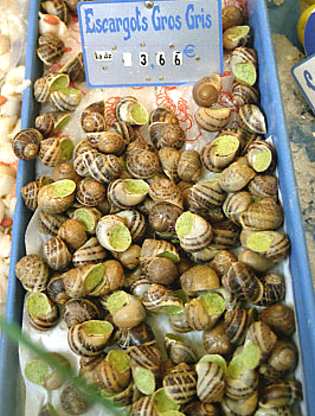
Family / Species and Author:
Common Name/s:
the French "petit-gris"
or small grey snail, escargot chagrine," or "La Zigrinata;
common snail
Quantity required:
12 "Fresh" Snails
- In the garden she had a little paddock (enclosure) where she would put the snails. When there were enough snails, she would stop feeding them for a week.
- She would then feed them with flour for a few days "to be fatty".
- Next, she would put them in the salt until they stoped drooling and then they ere rinsed off.
- They were then cooked in a court bouillon (water, white wine, parsley, little garlic, onion, thyme, salt, pepper...). When you can take them out of the shell,they are cooked. Cool
- Next, eliminate the entrails, the brown part at the end (if you leave it, it's bitter) and the operculum
- The
first part is over!
- 4 C fresh spinach,
stems removed,
julienne cut - 1/8 tsp salt
- 12 fresh snails
- 1/2 tsp Dijon mustard
- 4 tsp balsamic vinegar
- 1/4 C sour cream
- 2 tbs corn oil margarine
- 1/4 tsp fresh pepper
- 1/2 tsp extra-virgin olive oil
- 1/4 C water
Arrange 1 C of spinach on a plate in a nest. Heat margarine, salt & pepper in a pan, sautee snails & almonds until lightly browned. Drain & put 1 tsp of almonds in each nest.
Combine mustard, oil & vinegar in a pan & reduce by half over
med. heat. Add sour cream & water and blend. Spoon 2 tbs over each
nest.
- The European snail grows to 1 to 1 1/2 inches in shell size, has both reproductive organs. After mating, each are pregnant with an estimated 200 offspring a year.
- Snails are cold blooded and very sensitive to atmospheric temperatures and humidity. When conditions are not right for its activity it secretes mucus to seal its shell to hibernate until conditions are right.
- Snails are hermaphroditic but they mate to exchange sperm. They have both male and female reproductive organs. Some snails may act as males one season and females the next. Other snails play both roles at once and fertilize each other. When the snail is large enough and mature which is generally after they are 9 months old, they mate late spring early summer and late summer, early fall. They can store received sperm for their lifespan.
Recipe
by:
Sophie and JD Snails